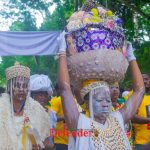CULTURE: Ipedi Festival And Development Of Edeland

By Okunlola Rafiu Olayemi
Ipedi festival is an annual festival and second most important festival in Ede apart from Sango festival. It takes place in July each year and it is associated with the arrival of the new yam.
Originally, the present Ede is not the one founded by the famous Timi Agbale Olofa-Ina, Ede cultural hero. Like Ibadan, the present Ede was established in the opening decades of the 19th century by the Oyo authorities, and had to be shifted to the other side of Osun river around 1817/1818. This change of settlement was largely in response to the breakdown of Oyo central authorities in 1796, due to the activities of Fulani Jihadist of Sheik Uthman Dan Fodio.
Sequel to the breakdown of normal government authorities, Yoruba land generally was thrown into confusion and anarchy, as powerful individuals started molesting and harassing innocent citizens, and it was during this same period that Kakanfo Afonja also successfully declared Ilorin independent of Oyo, from where he organised raids into Ede-Ile, Osogbo, Ilobu, Ejigbo and other towns in the area. It was this development that led to the evacuation of Ede Ile and the establishment of new Ede.
There was no doubt that if Ede was to be safe from Fulani attack and some powerful individuals in Oyo empire, it needed a natural barrier to shield her, hence, the relocation to the present site at the other side of Osun river led by Timi Kubolaje Agbonran.
The circumstances that led to the establishment of new Ede in the present site in 1818 by Timi Agbonran made them to take some security measures apart from natural shield of Osun River. It must be noted that means of ancient towns, cities to protect themselves is erection of city walls, moats, rivers, hills and so on. So, Ede was walled and it had four gates to protect the people from invaders and marauders. It was the duty of Chief Jagun to guard the gates and protect the city when Timi and Balogun went to war. The traditional gates are Bode Papa, Bode Apa, Bode ojoro and Bode sagba.
The erection of walls round Ede city was accompanied by Ipedi festival by Timi, the paramount ruler of Ede to serve dual purposes. Firstly, to mark the beginning of eating the new yam and secondly to make Timi sure that the gates are secured, as during Ipedi festival, Timi, accompanied by his chief led by Chief Jagun who double as chief priest of Ipedi the chief guard of the gates, priests, princes and princess, drummers and prominent sons and daughters of the town both home and abroad visit the city gates.
The festival which has a day programme commences with ‘Ilasu’ or ‘Ilaja’, that is, eating of the new yam by the king when rites are performed by Chief Jagun at Timi’smarket to commence buying and selling of the new yam for the year. Thereafter, the people of the town led by Timi will make procession to the three of the four city gates with the exception of ‘Bode Sagba’. However, ‘Bode Sagba’ is usually not visited, because it was the gates taken into the city when Timi Agbonran founded the present Ede.
Today, it is the tradition in Ede that any reigning Timi usually go round the city on horse and in addition visit his paternal and maternal family Compound where he will be hosted by heads of the compound and various gifts will be showered on the king at the occasion amidst drumming, singing and dancing while prayer will be offered for the king and for peace, prosperity and tranquility during his reign. In addition, sacrifices are made to other deities like Ogun, the god of iron and god of war which they believe is the chief protector of the city from foreign attack.
Conclusively, since the beginning of the Ipedi festival, Ede had been witnessing peace and tranquility and the town is experiencing a very rapid expansion, as people from other areas migrated to the town for the fact that they see Ede as a more sacred place to live and since then, the people of Ede have never failed to observe this festival each year, being one of the occasions that unite all the people of the town.









